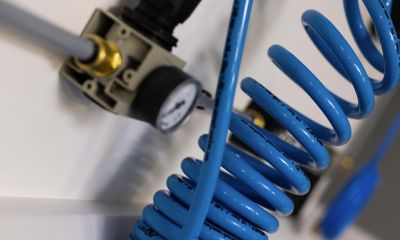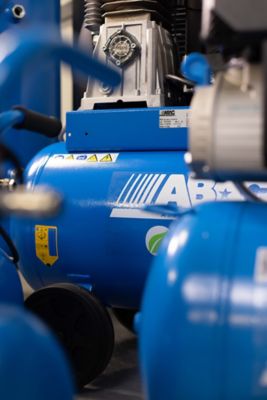Place the compressed air dryer after the receiver (and before main filtration) so it sees steadier temperature/flow and protects the whole network.
Setting up an efficient compressed air system in your workshop is essential for both performance and reliability. From selecting the right piping layout to ensuring proper pressure control and maintenance, each step plays a critical role in minimising losses and maximising uptime. This guide covers practical strategies and best practices to help you design, install, and maintain a robust air distribution network tailored to your workspace needs.
Table of Contents
Map Demand and Set a Baseline
Before you integrate an air compressor into an existing network, list tools, peak flow, and working pressure. Measure pressure at the farthest point while tools run, and do a quick leak audit. This baseline guides airline sizing, treatment choices and compressor settings.
Baseline checklist
- Tools/processes and their typical duty
- Pressure at compressor outlet, mid-loop and farthest outlet
- Visible leaks or hissing couplers
- Current receiver capacity and drain method
Build a Simple Treatment Train
Clean, dry air protects tools and finishes. Start centrally and add point-of-use care only where it matters.
- Drying: a compressed air dryer (refrigeration type) after the receiver for whole-network protection.
- Filtration: a general filter after the dryer; add finer coalescing only where required.
- Point-of-use: a filter regulator setup (FR/FRL) near sensitive tools for precise pressure and last-step filtering.
- Keep the run compact—short pipe between dryer, filter and main header minimises loss. Refer to ABAC air treatment ranges for compatible dryers and filters.
Receiver Strategy
Your receiver smooths demand peaks and reduces cycling.
- Reuse or add? If your cycle is spiky, an additional receiver near the main header can buffer flow.
- Drain plan: make draining quick (manual or auto drain).
- Isolation: add a service valve so the tank can be safely isolated when needed.
Workshop Piping That Won’t Choke Flow
Good workshop piping prevents early losses.
- Prefer short, direct runs; avoid tight elbows.
- Use sweep bends and keep take-offs from the top of headers to limit condensate carry-over.
- Consider a looped air distribution ring in larger spaces to equalise pressure.
Get Airline Sizing Right
Sizing is the easiest win: undersized lines cause avoidable pressure drop.
- Match bore to total flow and distance; size up when runs get long.
- Keep flexible hose lengths modest; use larger bore for long reels.
- Check actual tool pressure under load at the farthest point.
Tie-in Hardware and Vibration Control
- Non-return valve: fit a non-return valve (check valve) to prevent back-feeding, especially when connecting to an existing header or a second compressor.
- Isolation valves: place before/after key components for service.
- Flexible connectors: add short anti-vibration hoses between the compressor and rigid pipe to protect against movement.
- Condensate drops: put low-point drains at strategic spots.
Controls and Pressure Band
- Set sensible cut-in/cut-out so the pressure band suits your network without excessive cycling.
- With two compressors, stagger the setpoints (lead/lag) so one unit starts first; keep non-return valves in place to prevent backflow.
- Confirm rotation direction on screw models after wiring (where applicable) and check for alarms before loading.
Commission: Test, Record, Refine
- Leak test: pressurise, isolate sections and soap-test threaded joints.
- Flow check: verify pressure at the bench while a real tool runs.
- Dryer & filters: note differential pressure across the compressed air dryer and filters after warm-up.
- Baseline log: record outlet pressure, far-point pressure, compressor run/idle times, and drain frequency.
Keep it Reliable
- Weekly: drain receivers, quick visual leak check, gauge glance at the far point.
- Monthly: inspect couplers, clean/replace elements per schedule, re-torque any joints that needed PTFE tape early on.
- Quarterly: review logs; if pressure drop grows, revisit airline sizing or filter condition.
Integration FAQs — Quick Wins & Gotchas
Yes. A non-return valve prevents back-feeding between machines; pair it with staggered pressure band settings so one unit leads and the other supports.
Start from peak flow and distance. Size up the bore for longer runs and check pressure at the farthest tool under load—if it sags, the line is too small.
Use a compact FR/FRL near the bench: primary filter and regulator in one body; add finer filtration only for moisture-/finish-sensitive tools.
Often yes—if runs are short and bore is adequate. For long branches or pressure-sensitive tools, upgrade sections of workshop piping and keep take-offs tidy to avoid restrictions.















